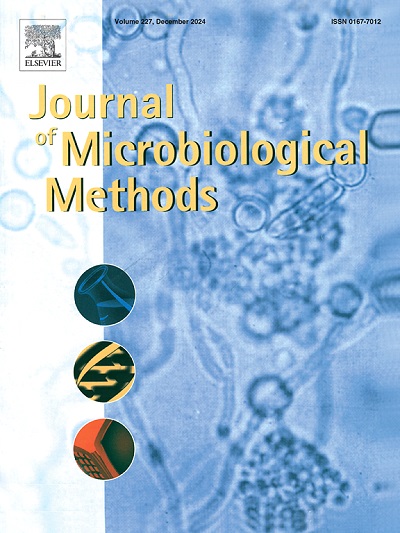检测革兰氏阴性菌中 qacEΔ1 基因的 TaqMan 实时 PCR 分析法
IF 1.9
4区 生物学
Q4 BIOCHEMICAL RESEARCH METHODS
引用次数: 0
摘要
通过移动遗传因子转移杀菌剂和抗生素抗性基因是细菌快速获得和传播抗药性的最常见机制。qacEΔ1 基因赋予细菌对季铵盐化合物(QAC)的抗药性。它也被认为是革兰氏阴性细菌中存在与多重耐药(MDR)表型相关的 1 类整合子的遗传标记。本研究开发了一种 TaqMan 实时 PCR 检测方法,用于检测革兰氏阴性细菌中的 qacEΔ1 基因。该检测方法每次反应的 qacEΔ1 基因检测限为 80 个拷贝。没有发现假阳性或假阴性结果。同时扩增和检测 16S rRNA 基因作为内源性内部扩增对照(IAC)。所开发的 TaqMan 实时 PCR 检测法是一种快速、灵敏和特异的方法,可用于监测革兰氏阴性菌对 QACs 的耐药性、1 类整合子的传播以及相关 MDR 表型的预测。本文章由计算机程序翻译,如有差异,请以英文原文为准。
A TaqMan real-time PCR assay for detection of qacEΔ1 gene in Gram-negative bacteria
The transfer of biocide and antibiotic resistance genes by mobile genetic elements is the most common mechanism for rapidly acquiring and spreading resistance among bacteria. The qacEΔ1 gene confers the resistance to quaternary ammonium compounds (QACs). It has also been considered a genetic marker for the presence of class 1 integrons associated with multidrug-resistant (MDR) phenotypes in Gram-negative bacteria. In this study, a TaqMan real-time PCR assay was developed to detect the qacEΔ1 gene in Gram-negative bacteria. The assay has a detection limit of 80 copies of the qacEΔ1 gene per reaction. No false-positive or false-negative results have been observed. Simultaneous amplification and detection of the 16S rRNA gene is performed as an endogenous internal amplification control (IAC). The TaqMan real-time PCR assay developed is a rapid, sensitive, and specific method that could be used to monitor resistance to QACs, the spread of class 1 integrons, and the prediction of associated MDR phenotypes in Gram-negative bacteria.
求助全文
通过发布文献求助,成功后即可免费获取论文全文。
去求助
来源期刊

Journal of microbiological methods
生物-生化研究方法
CiteScore
4.30
自引率
4.50%
发文量
151
审稿时长
29 days
期刊介绍:
The Journal of Microbiological Methods publishes scholarly and original articles, notes and review articles. These articles must include novel and/or state-of-the-art methods, or significant improvements to existing methods. Novel and innovative applications of current methods that are validated and useful will also be published. JMM strives for scholarship, innovation and excellence. This demands scientific rigour, the best available methods and technologies, correctly replicated experiments/tests, the inclusion of proper controls, calibrations, and the correct statistical analysis. The presentation of the data must support the interpretation of the method/approach.
All aspects of microbiology are covered, except virology. These include agricultural microbiology, applied and environmental microbiology, bioassays, bioinformatics, biotechnology, biochemical microbiology, clinical microbiology, diagnostics, food monitoring and quality control microbiology, microbial genetics and genomics, geomicrobiology, microbiome methods regardless of habitat, high through-put sequencing methods and analysis, microbial pathogenesis and host responses, metabolomics, metagenomics, metaproteomics, microbial ecology and diversity, microbial physiology, microbial ultra-structure, microscopic and imaging methods, molecular microbiology, mycology, novel mathematical microbiology and modelling, parasitology, plant-microbe interactions, protein markers/profiles, proteomics, pyrosequencing, public health microbiology, radioisotopes applied to microbiology, robotics applied to microbiological methods,rumen microbiology, microbiological methods for space missions and extreme environments, sampling methods and samplers, soil and sediment microbiology, transcriptomics, veterinary microbiology, sero-diagnostics and typing/identification.
 求助内容:
求助内容: 应助结果提醒方式:
应助结果提醒方式:


